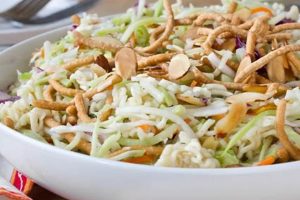Combinations of grated carrots, raisins, and a sweet dressing characterize a popular salad often served as a side dish. Typical dressings incorporate mayonnaise, yogurt, or a vinaigrette, and may include additional ingredients such as pineapple, nuts, or spices like cinnamon and ginger. Variations exist, offering a spectrum of flavors from tangy to creamy, and simple to complex.
This refreshing and lightly sweet dish offers nutritional value through the beta-carotene in carrots and the fiber and iron in raisins. Its adaptability makes it suitable for various occasions, from everyday meals to festive gatherings. Historically, sweet carrot salads emerged with increased access to sugar and dried fruits, eventually evolving into the familiar combinations enjoyed today. These salads offer a pleasant balance of textures and flavors, contributing a vibrant element to any meal spread.
This article will explore various aspects of creating these salads, including different dressing options, ingredient variations, tips for preparation and storage, and suggestions for complementary dishes.
Tips for Carrot Raisin Salad Preparation
Achieving optimal flavor and texture requires attention to several key aspects of preparation. The following tips offer guidance for creating a successful and enjoyable salad.
Tip 1: Grate Carrots Uniformly: Uniformly grated carrots ensure even coating with the dressing and contribute to a pleasant texture. A box grater or food processor provides consistent results.
Tip 2: Plump the Raisins: Hydrating raisins in warm water or juice for 10-15 minutes prior to adding them to the salad plumps them, enhancing their sweetness and texture.
Tip 3: Balance Sweetness and Acidity: A well-balanced dressing is crucial. Taste and adjust the sweetness and acidity to achieve a harmonious flavor profile.
Tip 4: Consider Texture: Adding chopped nuts, such as walnuts or pecans, provides a contrasting textural element. Shredded coconut offers another interesting textural dimension.
Tip 5: Chill Before Serving: Chilling the salad for at least 30 minutes allows the flavors to meld and enhances the refreshing quality of the dish.
Tip 6: Freshness is Key: Utilizing fresh, high-quality carrots and properly stored raisins contributes significantly to the overall flavor and enjoyment.
Tip 7: Explore Variations: Experiment with different dressings, spices, and additions like pineapple or apple to discover preferred flavor combinations.
Attention to these details elevates this simple salad to a more refined and satisfying culinary experience.
By incorporating these tips, one can confidently create a delicious and visually appealing carrot raisin salad suitable for any occasion.
1. Ingredients
Ingredient selection significantly impacts the final flavor profile and overall quality of carrot raisin salad. Core ingredients typically include grated carrots and raisins. Carrots provide sweetness and a crisp texture, while raisins contribute chewiness and concentrated sweetness. The choice of dressing binds these elements and adds depth of flavor. Common dressing ingredients include mayonnaise, yogurt, or a vinaigrette base. Mayonnaise offers a creamy richness, yogurt provides tanginess, and vinaigrettes contribute a lighter, brighter flavor. Beyond these core components, variations often incorporate additional ingredients such as pineapple, apple, nuts, or spices like cinnamon and ginger. Pineapple introduces a tropical sweetness and acidity, while apple adds a tart crispness. Nuts provide textural contrast and earthy notes, and spices introduce warmth and complexity. The interplay of these ingredients determines the overall sensory experience of the salad.
Careful consideration of ingredient quality is paramount. Fresh, crisp carrots offer the best flavor and texture. Plump, moist raisins ensure optimal sweetness and chewiness. Using high-quality mayonnaise, yogurt, or fresh vinaigrette ingredients contributes to a superior dressing. Likewise, selecting fresh, ripe fruits and high-quality nuts and spices further enhances the salad’s flavor profile. For example, using stale raisins or wilted carrots can negatively impact the overall quality, resulting in a less enjoyable salad. Conversely, selecting flavorful, in-season carrots and plump raisins elevates the dish. Understanding the role of each ingredient allows for informed substitutions and creative adaptations based on individual preferences and dietary needs.
Ingredient selection represents a crucial step in crafting a successful carrot raisin salad. Balancing the sweetness of carrots and raisins with the acidity and richness of the dressing, along with thoughtful incorporation of additional ingredients, allows for a wide range of flavor profiles. Prioritizing fresh, high-quality ingredients ensures a delightful culinary experience. This understanding empowers individuals to create personalized variations and appreciate the nuanced interplay of flavors and textures in this versatile dish.
2. Dressing Variations
Dressing variations play a pivotal role in defining the character of carrot raisin salad. The dressing serves not only to bind the ingredients but also to contribute significantly to the overall flavor profile, texture, and appearance of the salad. A well-chosen dressing elevates the simple combination of carrots and raisins, transforming it into a cohesive and flavorful dish. The interplay between the sweetness of the carrots and raisins and the characteristics of the dressing is crucial for achieving a balanced and enjoyable salad.
Several dressing archetypes offer distinct flavor profiles. Creamy dressings, often based on mayonnaise or yogurt, provide richness and tang. A mayonnaise-based dressing lends a classic, comforting flavor, while a yogurt-based dressing offers a lighter, tangier alternative. The addition of ingredients like sour cream or buttermilk further modulates the creaminess and acidity. Vinaigrettes, composed of oil and vinegar, offer a brighter, more acidic counterpoint to the sweetness of the carrots and raisins. The choice of vinegar, such as apple cider, white wine, or balsamic, significantly impacts the final flavor. Sweet dressings, often incorporating honey, maple syrup, or fruit juices, enhance the natural sweetness of the ingredients. The careful balance of sweet and acidic elements within these dressings is crucial. For example, a honey-mustard dressing combines the sweetness of honey with the tang of mustard, creating a complex and balanced flavor profile. Similarly, a citrus vinaigrette balances the tartness of citrus juice with the richness of oil.
Understanding the impact of dressing variations allows for informed choices tailored to individual preferences and dietary needs. Creamy dressings lend themselves to richer, more decadent salads, while vinaigrettes create lighter, more refreshing options. Sweet dressings emphasize the natural sweetness of the carrots and raisins, while more savory dressings provide contrast. The choice of dressing ultimately determines the overall character of the salad, showcasing the versatility of this seemingly simple dish. Consideration of the dressing’s flavor profile, texture, and acidity allows for a more nuanced and satisfying culinary experience.
3. Preparation Techniques
Preparation techniques significantly influence the final texture, flavor, and overall quality of carrot raisin salad. While seemingly straightforward, attention to detail in each step of preparation elevates this simple dish. The manner in which carrots are handled, raisins are prepared, and the dressing is incorporated impacts the final result. Understanding the cause-and-effect relationship between preparation techniques and the finished product allows for greater control over the salad’s characteristics.
For instance, grating carrots finely results in a softer texture, while coarsely grated carrots offer more bite. Soaking raisins in warm water or juice prior to incorporating them into the salad plumps them, resulting in a more flavorful and texturally appealing ingredient. The order in which ingredients are combined also plays a role. Adding the dressing just before serving prevents the salad from becoming soggy, maintaining a desirable texture. Similarly, incorporating delicate ingredients like nuts or fresh herbs at the last minute preserves their crispness and flavor. Consider a scenario where carrots are grated too far in advance and exposed to air; they may oxidize and develop an undesirable flavor. Conversely, properly stored, freshly grated carrots retain their vibrant color and flavor. These examples illustrate the practical significance of understanding the impact of preparation techniques.
Mastery of preparation techniques allows for consistent, high-quality results and customization based on individual preferences. Whether seeking a finely textured salad or one with a more substantial bite, understanding the nuances of preparation unlocks the full potential of this versatile dish. Attention to seemingly minor details, such as the size of the carrot grate or the timing of dressing incorporation, ultimately determines the overall sensory experience. This knowledge empowers individuals to create a carrot raisin salad tailored to specific desires and consistently achieve optimal results.
4. Flavor Profiles
Flavor profiles significantly influence the sensory experience of carrot raisin salad, differentiating variations and catering to individual preferences. Understanding the interplay of ingredients and how they contribute to specific flavor profiles allows for greater control over the final product. A well-defined flavor profile elevates the salad beyond a simple combination of ingredients, creating a more nuanced and enjoyable culinary experience.
- Sweet and Tangy
This classic profile balances the natural sweetness of carrots and raisins with a tangy element, often achieved through the incorporation of acidic ingredients in the dressing. Examples include dressings based on yogurt, buttermilk, or vinaigrettes featuring citrus juices or apple cider vinegar. Pineapple chunks also contribute to this profile. The interplay of sweet and tangy creates a refreshing and vibrant flavor combination, particularly suited for warmer weather or as a palate cleanser.
- Sweet and Spicy
This profile layers warmth and complexity onto the base sweetness of the salad. Common additions include spices such as cinnamon, ginger, nutmeg, or allspice, often incorporated into the dressing or sprinkled directly onto the salad. The level of spice can be adjusted to suit individual preferences, ranging from a subtle hint of warmth to a more pronounced spiciness. This profile often complements autumnal or winter meals.
- Creamy and Nutty
Creamy dressings, typically mayonnaise-based, form the foundation of this profile. The addition of chopped nuts, such as walnuts, pecans, or almonds, introduces a textural contrast and a rich, earthy flavor. Toasted coconut flakes can further enhance the creamy, nutty notes. This profile offers a more decadent and satisfying salad experience.
- Fruity and Fresh
This profile emphasizes the natural sweetness of the salad by incorporating additional fruits like diced apples, oranges, or shredded coconut. These additions introduce varied textures and flavors, enhancing the overall freshness and complexity. Lighter dressings, such as citrus vinaigrettes or yogurt-based dressings, complement this profile without overpowering the delicate fruit flavors.
By understanding these distinct flavor profiles, individuals can tailor carrot raisin salad recipes to specific preferences and occasions. The intentional combination of ingredients and dressings allows for a diverse range of culinary experiences, demonstrating the versatility of this seemingly simple dish. Whether seeking a refreshing summer salad or a comforting autumnal side, careful consideration of flavor profiles unlocks a world of possibilities.
5. Health Benefits
Carrot raisin salad, beyond its appealing flavor and texture, offers notable health benefits derived from its key ingredients. Understanding these nutritional contributions provides a deeper appreciation for this simple dish and its potential role in a balanced diet. The synergistic combination of carrots, raisins, and other potential additions contributes a range of vitamins, minerals, and antioxidants.
- Beta-Carotene and Vision Health
Carrots are rich in beta-carotene, a precursor to vitamin A, essential for maintaining good vision. Beta-carotene acts as an antioxidant, protecting eye cells from damage caused by free radicals. Regular consumption of beta-carotene-rich foods like carrots may contribute to reducing the risk of age-related macular degeneration and cataracts. In the context of carrot raisin salad, the readily available beta-carotene offers a convenient and palatable way to support eye health.
- Fiber and Digestive Health
Both carrots and raisins contribute dietary fiber, crucial for maintaining a healthy digestive system. Fiber promotes regular bowel movements, prevents constipation, and supports a healthy gut microbiome. Adequate fiber intake also contributes to feelings of fullness, potentially aiding in weight management. The combined fiber content of carrots and raisins in the salad provides a readily accessible source of this essential nutrient.
- Iron and Energy Levels
Raisins are a good source of iron, a mineral essential for red blood cell production and oxygen transport throughout the body. Iron deficiency can lead to fatigue and decreased energy levels. Including raisin-rich foods like carrot raisin salad in the diet can contribute to maintaining healthy iron levels, particularly for individuals at risk of iron deficiency. The natural sugars present in raisins also provide a readily available energy source.
- Potassium and Blood Pressure Regulation
Carrots contain potassium, an electrolyte that plays a vital role in regulating blood pressure. Potassium helps counter the effects of sodium, potentially reducing the risk of hypertension. Including potassium-rich foods like carrots in a balanced diet contributes to overall cardiovascular health. While the potassium content in a single serving of carrot raisin salad might not be substantial, it contributes to the cumulative intake of this essential mineral.
Consuming carrot raisin salad offers a convenient and palatable way to incorporate these beneficial nutrients into one’s diet. While the specific nutritional content varies depending on the recipe and additional ingredients, the core components of carrots and raisins provide a foundation of vitamins, minerals, and antioxidants that contribute to overall well-being. Incorporating this salad as part of a balanced diet, along with other nutrient-rich foods, can contribute to long-term health and wellness.
6. Serving Suggestions
Serving suggestions enhance the versatility of carrot raisin salad, transforming it from a simple side dish to a component of diverse culinary experiences. Consideration of complementary flavors, textures, and overall meal composition elevates the perceived value of this adaptable salad. Strategic serving suggestions broaden the appeal of carrot raisin salad, integrating it into a wider range of meal contexts.
The salad’s inherent sweetness and textural complexity allows for pairing with both savory and sweet dishes. As a side dish, it complements grilled meats, roasted poultry, or fish, providing a refreshing counterpoint to richer flavors. Its sweetness also harmonizes with spicier cuisines, offering a cooling element. Incorporating the salad into sandwiches or wraps adds textural and flavor dimension. It can also serve as a topping for yogurt parfaits or breakfast bowls, introducing a touch of sweetness and nutritional value. For example, a curried chicken salad sandwich benefits from the textural and flavor contrast provided by carrot raisin salad, while a simple yogurt parfait gains complexity and nutritional value with its addition.
Effective serving suggestions highlight the adaptability of carrot raisin salad, expanding its culinary applications beyond the traditional side dish. This understanding enables integration into diverse meal plans and cuisines, maximizing the potential of this versatile and nutritious salad. By considering complementary flavors and textures, one can transform carrot raisin salad into a valuable component of a wide array of culinary creations.
7. Storage Methods
Proper storage methods are crucial for maintaining the quality, flavor, and safety of carrot raisin salad. Effective storage preserves the freshness of ingredients, prevents spoilage, and maximizes the shelf life of the prepared salad. Understanding optimal storage techniques ensures a safe and enjoyable culinary experience, minimizing food waste and preserving the intended flavor profile of the recipe.
- Refrigeration
Refrigeration is the primary method for storing carrot raisin salad. An airtight container is essential for preventing the salad from drying out and absorbing odors from other foods in the refrigerator. Properly sealed, carrot raisin salad can be stored in the refrigerator for up to 3-5 days. Beyond this timeframe, the quality and safety of the salad may decline. Maintaining a consistent refrigerator temperature below 40F (4C) inhibits bacterial growth and preserves the freshness of the ingredients.
- Freezing (Not Recommended)
Freezing carrot raisin salad is generally not recommended. The high water content of carrots and the presence of mayonnaise or yogurt-based dressings make the salad susceptible to undesirable textural changes upon thawing. Freezing can cause the carrots to become mushy and the dressing to separate, significantly impacting the overall quality and palatability of the salad. While some ingredients, such as carrots and raisins, can be frozen individually, combining them in a dressed salad creates a less desirable outcome after freezing and thawing.
- Ingredient Storage
Proper storage of individual ingredients before preparing the salad is equally important. Carrots should be stored in a cool, dark place, such as a refrigerator crisper drawer, to maintain their crispness and prevent moisture loss. Raisins should be stored in an airtight container in a cool, dry place to prevent them from drying out or becoming sticky. Other ingredients, such as nuts or fruits, should be stored according to their specific requirements to maintain optimal freshness before incorporation into the salad.
- Serving and Leftovers
When serving carrot raisin salad, avoid leaving it at room temperature for extended periods, especially in warm environments. Bacterial growth can occur rapidly at temperatures between 40F (4C) and 140F (60C), increasing the risk of foodborne illness. Refrigerate any leftover salad promptly after serving to maintain its quality and safety. Discard any salad left at room temperature for more than two hours.
Adhering to these storage guidelines ensures the safety and maximizes the enjoyment of carrot raisin salad. Proper storage preserves the intended flavors and textures, preventing spoilage and maximizing the shelf life of the prepared dish. By understanding and implementing these methods, individuals can confidently prepare and enjoy carrot raisin salad while minimizing food waste and prioritizing food safety.
Frequently Asked Questions
This section addresses common inquiries regarding carrot raisin salad recipes, providing concise and informative responses to clarify potential uncertainties and enhance understanding of this versatile dish.
Question 1: How can one prevent carrot raisin salad from becoming watery?
Excess moisture can accumulate due to several factors, including the water content of the carrots and the type of dressing used. Grating carrots finely can release more moisture. To minimize wateriness, consider salting grated carrots and allowing them to sit for a short period before incorporating them into the salad. This process draws out excess moisture. Additionally, opting for thicker dressings, such as mayonnaise-based options, or adding a small amount of drained crushed pineapple can help absorb excess liquid and maintain a desirable texture.
Question 2: What are suitable alternatives to mayonnaise in dressings?
Alternatives to mayonnaise offer variations in flavor and cater to dietary restrictions. Plain yogurt or Greek yogurt provide a tangier, lower-fat option. A mixture of mashed avocado and lime juice creates a creamy, dairy-free alternative. Vinaigrettes based on olive oil and vinegar offer a lighter, brighter dressing option. These alternatives allow for customization based on individual preferences and dietary needs.
Question 3: Can this salad be prepared in advance?
Advance preparation is possible with considerations for ingredient freshness and texture. Preparing the grated carrots, raisins, and other components separately and combining them just before serving ensures optimal texture and flavor. The dressing can also be prepared in advance and stored separately. This approach prevents the salad from becoming soggy and maintains the crispness of the ingredients.
Question 4: How long can carrot raisin salad be stored safely?
Properly stored in an airtight container in the refrigerator, carrot raisin salad typically remains safe to consume for 3-5 days. Beyond this timeframe, the risk of bacterial growth increases, potentially compromising food safety. Visual inspection and assessment of odor are essential for determining the freshness of the salad before consumption.
Question 5: What are some creative variations on the classic recipe?
Numerous variations exist, allowing for customization of flavor profiles and textures. Incorporating ingredients like shredded coconut, chopped apples, pineapple chunks, or toasted nuts adds complexity and textural contrast. Experimenting with different spices, such as cinnamon, ginger, or nutmeg, introduces unique flavor dimensions. Substituting different types of raisins, such as golden raisins or currants, further alters the flavor profile.
Question 6: What are the key considerations for achieving a well-balanced flavor profile?
Balancing sweetness, acidity, and textural elements are key considerations for a successful carrot raisin salad. The sweetness of carrots and raisins should be balanced by the acidity of the dressing. Tart ingredients like pineapple or apple can enhance this balance. Incorporating nuts or seeds provides textural contrast, while spices add depth and complexity. A harmonious blend of these elements contributes to a more satisfying culinary experience.
Understanding these common inquiries empowers informed choices in recipe selection, preparation, and storage, maximizing the enjoyment and culinary potential of carrot raisin salad.
This concludes the frequently asked questions section. The following section will explore [Next Section Topic].
Carrot Raisin Salad Recipes
Exploration of carrot raisin salad recipes reveals a dish adaptable to diverse palates and culinary contexts. From ingredient selection and dressing variations to preparation techniques and storage methods, understanding the nuances of this seemingly simple salad unlocks its full potential. Balancing the sweetness of carrots and raisins with complementary flavors and textures creates a harmonious and enjoyable culinary experience. Consideration of health benefits further elevates the value of this versatile dish.
Carrot raisin salad recipes offer a canvas for culinary creativity, allowing for personalized interpretations and innovative flavor combinations. Further exploration and experimentation promise continued enjoyment and appreciation of this adaptable and nutritious dish, enriching culinary traditions and promoting healthy eating habits.






